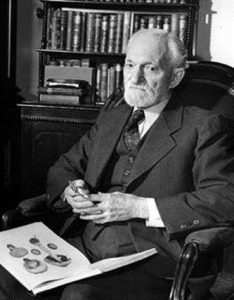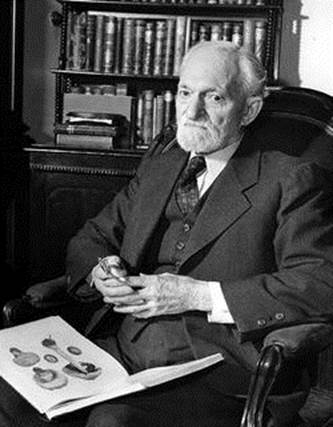(1852 – 1954)
Q4159012
The University of North Carolina at Chapel Hill Herbarium (NCU) curates at least 261 specimens collected by John Dearness; all are fungi from Canada.
Images of specimen labels of NCU’s fungal collection, including those collected by John Dearness, are available online via mycoportal.org
Fungal specimens collected by John Dearness can be found in many herbaria across North America.

The following is excerpted from:
Estey, Ralph H. (1993) John Dearness (1852-1954): Canadian pioneer mycologist-plant pathologist. Phytoprotection 74: 135-141.
Born in Hamilton, Ontario on 13 May 1852, of parents who had come to Canada from the Orkney Islands, young Dearness spent much of his youthful years on farms near St. Marys, Ontario. It was there that he acquired a love of nature that lasted throughout his long life of 102 years…
At 18 he attended the Toronto Normal School where he distinguished himself as a teacher-trainee and won a special certificate in “Natural History, Botany and Agricultural Chemistry.” He graduated in 18712, with the highest honors and a teacher’s certificate. Later that year he became Principal of the school in the village of Lucan, Ontario. Two years later he was made Principal of a larger school in Strathroy, Ontario. Recognizing his ability as a teacher-administrator, the educational authorities made Dearness a Public School Inspector for East Middlesex county in 1874, a position which he held for 25 years…
In addition to being Inspector of Schools from 1874 to 1899, he was Professor of Botany and Zoology in the Medical School of Western University (now the University of Western Ontario) from 188 to 1914. [Dearness was Vice-Principal in 1899, then Principal in 1918 of the London Normal School.] In the meantime his interest in nature study, especially botany and the fungi that incite plant diseases, had become widely known and he was appointed Examiner in Botany for the University of Toronto in 1900…
In 1902 he earned his first degree, a B.A., from the University of Western Ontario, when he was 50 yr old. He was awarded a M.A. by that university the following year… His early interest in plant diseases is seen in the minutes of the Microscopical Section of the Entomological Society of Ontario, London, of which he was a founding member… While studying the powdery mildew fungi on leaves, Dearness became interested in the fungi that cause rust diseases in plants. He is said to have made the first report on the wheat rust, Puccinia graminis Pers., in Canada. The first volume of the journal Erythea, published in December 1893, has the names of five species of Puccinia, and one of Uromyces, named by Dearness and his friend and long-time collaborator, Homer D. House, of the New York Botanic Garden. J. C. Arthur, in his 1934 book Manual of the rusts in United States and Canada, lists no fewer than 20 rust fungi that were originally named by Dearness and House. When he was 88 years old, Dearness was still collaborating with House in naming new and noteworthy species of New York fungi. Their 1940 list included Phyllosticta dearnessii D. & H., a leaf parasite that had obviously been named in honor of Dearness…
Dearness’ interest in plant pathology is clearly seen in his report on the fungi collected by the naturalists of the 1913-1918 Canadian Arctic Expedition. He commented on how surprised he was to see the relatively small number of summer stages of parasitic fungi and the wide range of host plants inhabited by one species…
After a fire destroyed the herbarium of the University of Tennessee in 1934, Dearness became interested in the fungi of that State. The list of new species of Tennessee fungi, that he published in 1941, included several plant parasites and the name of their host plants…
The city of London, Ontario, made Dearness a Freeman of that City on the occasion of his 90th birthday, in 1942. When the Imperial Order of the Daughters of the Empire, in London, received their charter on 9 May 1945, it was under the name of the Dr. John Dearness Chapter, and when he was 101 years old, in 1953, the John Dearness Home for Senior Citizens in London was named in his honor. It was only after he was 100 years old, when his hearing and his eyesight deteriorated so much that he could no longer enjoy his hobby as an active naturalist, that John Dearness welcomed the death that came to him on 6 December 1954.
PUBLICATIONS
Dearness, J. (1897) Annual address of the President. Ann. Rep. Entomol. Soc. Ont. 27: 2-30.
Ellis, J. B. and J. Dearness (1899) New species of Canadian fungi. Trans. Can. Inst. 6: 637-640.
Dearness, J. (1905) The nature study course, with suggestions for teaching it based on notes and lectures of teachers in training. The Copp, Clark Co., Ltd. Toronto, Ontario.
Dearness, J. (1923) Report of the Canadian Arctic Expedition 1913-1918. Vol. IV, Botany, Part c: Fungi.
Dearness, J. (1925) A mycologist at large. Phytopathology 15: 301.
Dearness, J. (1925) Forest and shade tree diseases. Pp. 61-68 in Fifth Ann. Rep. on the Prevalence of Plant Diseases in Canada. Exp. Farms Branch, Dom. Dep. Agric. Ottawa, Ontario.
Dearness, J. (1926) New and noteworthy fungi, IV. Mycologia 18: 236-255.
Dearness, J. (1926) An annotated list of Anthracnoses in the open and under glass in Canada and the adjoining United States. Dom. Dep. Agric. Div. Bot., Bull. 71, Appendix 1.
Dearness, J. (1926) Some fungus foes of the flower garden. A locality list with notes. Phytopathology 16: 756-757.
Dearness, J. (1929) New and noteworthy fungi, VI. Mycologia 21: 326-332.
Bisby, G. R., A. H. R. Buller, and J. Dearness (1929) The fungi of Manitoba. Longmans, Green & Co., London, England.
Dearness, J. (1929) Observations on needle blight of white pine. Phytopathology 19: 413.
Dearness, J. and G. B. Sanford (1930) A new species of Plenodomus. Ann. Mycol. 28: 324-325.
Dearness, J. and W. R. Foster (1933) Anther and stigma blight of loganberry. Can. J. Res. 9:43.
Dearness, J. and J. R. Hansbrough (1934) Cytosporia infection following fire injury in western British Columbia. Can. J. Res. Sect. C. Bot. Sci. 10: 125-128.
Dearness, J., J. L. Howatt and S. F. Clarkson (1936) A new disease of apples caused by Dasycarpoma allantoideum (Peck) Dearness. Proc. Can. Phytopathol. Soc. 6: 10.
Dearness, J. (1938) The background of mycology and Mycologia. Mycologia 30: 111-119.
Dearness, J. (1938) Sphaceloma rosarum as Gloeosprorium rosaecola. Mycologia 30: 561-562.
Dearness, J. and W. R. Foster (1938) Coniosporium diseases of apples and crab-apples. Can. J. Res. Sec. C Bot. Sci. 16: 574-276.
Dearness, J. (1939) Reminiscences of the early days of the Society. Can. Entomol. 71: 21-24.
Dearness, J. and H.D. House (1940) New and noteworthy species of New York fungi. N.Y. State Mus. Circ. 24: 25-60.
Dearness, J. (1941) New species of Tennessee fungi. Mycologia 33: 360-366.
SOURCES:
